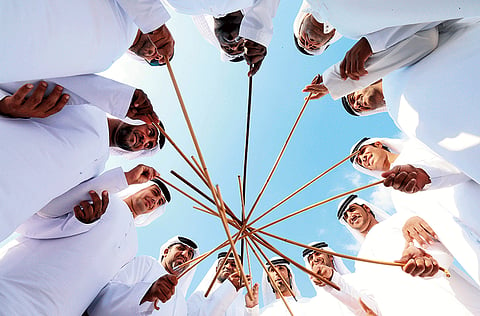N for Nationhood: Rooted in tradition
As part of our A to Z of the UAE, we find out how the nation keeps its heritage alive in the face of rapid modernistation

While development has taken place on an unprecedented and massive scale in the UAE — especially over the past two decades — there is a deep awareness that traditions which once formed the mainstay of past generations may get lost in the clamour of modern life. Several strategies focus on preserving the country’s cultural legacy and familiarising current generations with the lives of their resilient forefathers.
Much effort is being made to ensure that physical evidence of the UAE’s rich heritage is not lost and this is led by the conservation of its archaeological and architectural sites. For example, scattered across the country are forts and watchtowers that were built decades ago to guard territories or trading posts, as well as as residences of rulers and seats of local governance. Many of these structures have been restored or partly reconstructed and now house museums showcasing a forgotten way of life.
Historical traditions once born of necessity are given great importance: old customs and folkloric literature are widely studied in schools, while heritage villages and special events help create context for this rich cultural legacy. A notable example is the Traditional Handicrafts Festival organised by Abu Dhabi Tourism and Culture Authority. Now in its third year, the ten-day annual event held at the historic Souq Al Qattara in Al Ain aims to promote Emirati families who pass down their artisanal skills to younger generations.
Another aspect of preserving heritage can be seen in the many icons and symbols that serve as the insignia of nationhood. Some such as the coffee pot, dhow, date palm, camel, falcon and Arabian oryx are imprinted on coins and currency notes or feature in art and architecture.
Apart from the faux wind towers perched on contemporary buildings, the UAE’s renowned architecture pays distinct homage to its heritage. The nomadic Bedouin who once lived off this land used animal skins to build homes that were easy to construct and maintain could withstand harsh climatic conditions. Today, the humble black Bedouin tent, which translates from the Arabic beyt al sha’ar as house of hair, is hailed as ingenious vernacular architecture.
Architects have also made much of the wooden boat or dhow, once the mainstay of the emirates’ economy and important to regional trade. The dhow’s sail is indelibly associated with the Burj Al Arab, often called the world’s only seven-star hotel. Its billowing sail silhouette features a double-skinned, Teflon-coated woven glass fibre screen across a ribbed belly. The new Dubai Opera building is also modelled on the dhow, in which the bow of the boat-shaped building houses the main stage and seating, while the elongated hull includes parking.
The dhows themselves show no signs of disappearing: traditional boatyards in the UAE continue this ancient tradition, using the same basic materials and tools to fashion these elegant boats.
Several other facets of the UAE’s heritage are alive and well across the country. A visit to any local event or festival will confirm that the rich traditions of Emirati poetry, calligraphy and storytelling, as well as some of its age-old sports such as falconry, camel racing, sailing and bull-butting are truly alive. Some, such as the Million’s Poet reality show, an American Idol-style poetry slam, have elevated nabati verse into an international cultural phenomenon.
The UAE has different styles of music and dance that reflect the old traditions of the land and has kept them alive despite rapid transformation to modernity. Many of these date back to life in the desert and people who encountered immeasurable hardships
in their everyday lives. Music and dance played a major role in helping them overcome obstacles and celebrate victories.
Mundane tasks had songs and specific rhythms to foster teamwork; ingenious musical instruments were developed out of dried animal skin and parts; poetry recitals were part of every gathering; and symbolic dances marked special occasions. All are re-enacted with modern interpretations today, at festivals, weddings, and public celebrations across the country.
Clothing too takes on cultural significance in the UAE, and it stands out as a country where the majority of its people wear national dress in daily life, unlike elsewhere where it is reserved for celebrations and occasions. Emiratis use their national dress to express pride in their heritage.
As the UAE moves towards embracing and integrating into a greater global culture, its customs and traditions form an essential part of the country’s identity and self-awareness.
State symbols
The flag of the UAE was based on the winning entry by Abdullah Mohammad Al Ma’enah in an October 1971 competition run by the Amiri Diwan of Abu Dhabi. It was first raised at the UN in New York on December 10, 1971.
The national anthem was composed in 1971 by Egyptian Mohammad Abdul Wahab, and the lyrics were written by Emirati poet Arif Al Shaikh Abdullah Al Hassan in 1986.
The emblem of the UAE, officially adopted in 1973 and modified in 2008, features a golden falcon, a disk with the flag colours and seven stars. The falcon with seven tail feathers holds a red parchment with the name of the federation in Arabic.
Sign up for the Daily Briefing
Get the latest news and updates straight to your inbox


